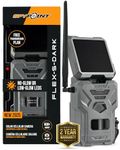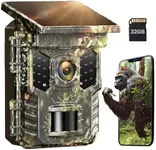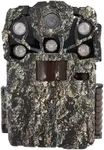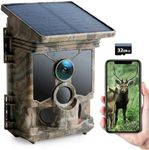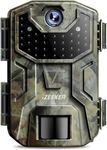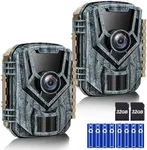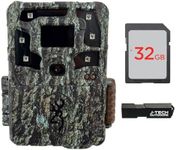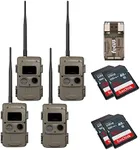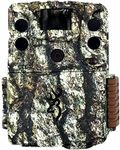Buying Guide for the Best Trail Cameras
When choosing a trail camera, it's important to think about how and where you'll use it. Trail cameras are used for wildlife monitoring, hunting, or even security, and the right one for you depends on your specific needs. Start by considering the environment where you'll place the camera, how often you can check it, and what kind of images or videos you want to capture. Understanding the key features will help you make a choice that matches your expectations and ensures you get the most out of your camera.Image ResolutionImage resolution refers to the number of pixels in each photo the camera takes, usually measured in megapixels (MP). Higher resolution means clearer and more detailed images, which is important if you want to identify animals or people from a distance. Cameras with lower resolution (under 8MP) are fine for basic monitoring, while mid-range (8-16MP) offers a good balance for most users. High resolution (over 16MP) is best if you need sharp, detailed images for identification or sharing. Choose based on how clear you need your photos to be and how much storage space you have, since higher resolution images take up more space.
Trigger SpeedTrigger speed is how quickly the camera takes a photo after detecting movement. A faster trigger speed means the camera is more likely to capture fast-moving animals or people. Slow trigger speeds (over 1 second) might miss quick subjects, while moderate speeds (0.5-1 second) are suitable for most wildlife. Fast trigger speeds (under 0.5 seconds) are ideal for capturing fast action or smaller animals. If you expect a lot of movement or want to catch every moment, look for a faster trigger speed.
Detection RangeDetection range is the distance at which the camera can sense motion and trigger a photo or video. Short ranges (under 50 feet) are fine for small clearings or close-up monitoring, while medium ranges (50-80 feet) work well for most trails and open areas. Long ranges (over 80 feet) are best for wide-open spaces or if you want to cover a larger area. Think about where you'll place the camera and how far away the subjects are likely to be when choosing the right detection range.
Night VisionNight vision allows the camera to take photos or videos in the dark using infrared LEDs. Some cameras have basic night vision with visible flashes, while others use invisible (no-glow) LEDs that won't scare animals or alert people. Basic night vision is fine for general use, but if you want to avoid disturbing wildlife or need stealth for security, look for no-glow or low-glow options. Consider how much nighttime activity you expect and whether you need to be discreet.
Battery LifeBattery life determines how long the camera can operate before you need to replace or recharge the batteries. Short battery life (a few weeks) is manageable if you can check the camera often, while longer battery life (several months) is better for remote locations or if you want less maintenance. Some cameras also support external power sources or solar panels for extended use. Think about how often you can visit the camera and how much effort you want to spend on maintenance.
Storage OptionsStorage options refer to how the camera saves photos and videos, usually on SD cards. Smaller cards (up to 16GB) fill up quickly, especially with high-resolution images or videos, while larger cards (32GB or more) can store more data between checks. Some cameras also offer wireless transfer or cloud storage, which is useful if you want to access images remotely. Choose based on how often you can check the camera and how much data you expect to collect.
Weather ResistanceWeather resistance means how well the camera can handle rain, snow, dust, and temperature changes. Basic weatherproofing is enough for mild climates, but if you plan to use the camera in harsh conditions, look for models with higher ratings for water and dust resistance. Consider the typical weather in your area and how exposed the camera will be when making your choice.


